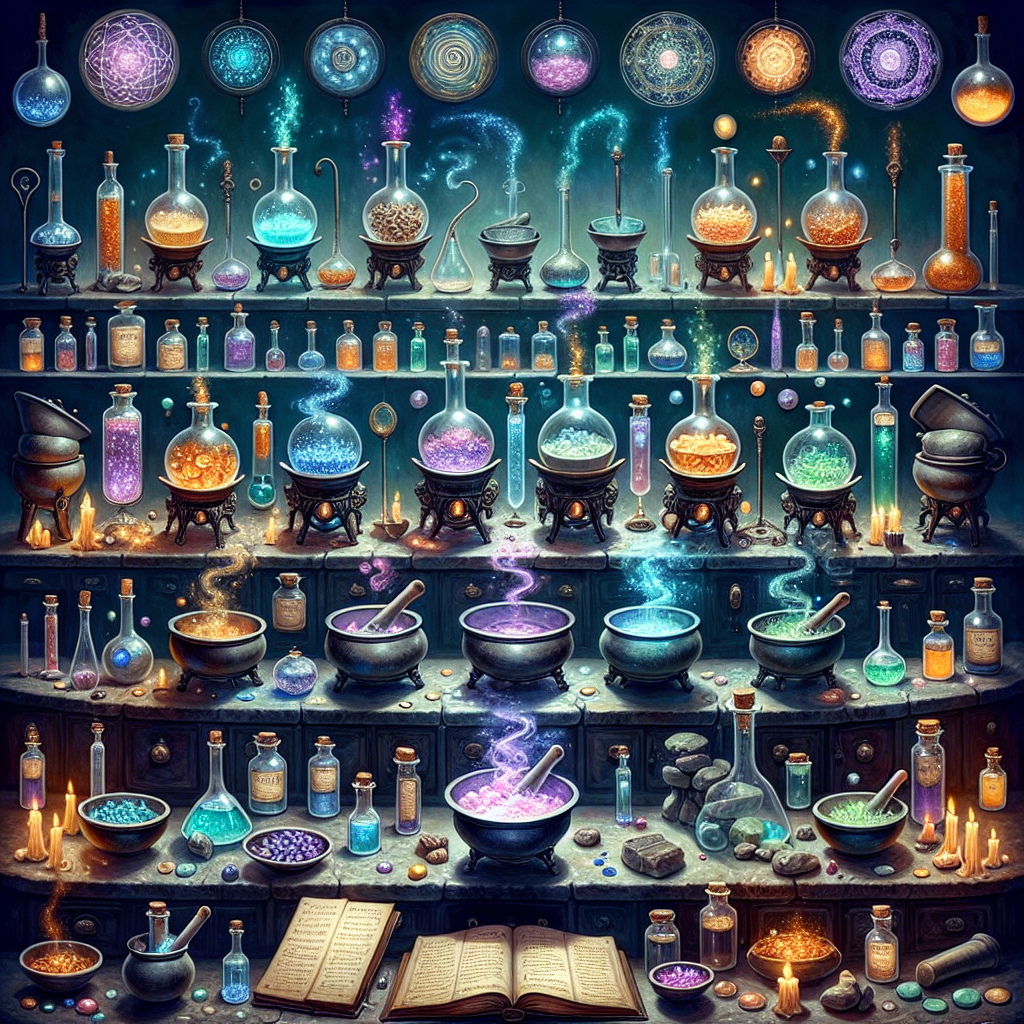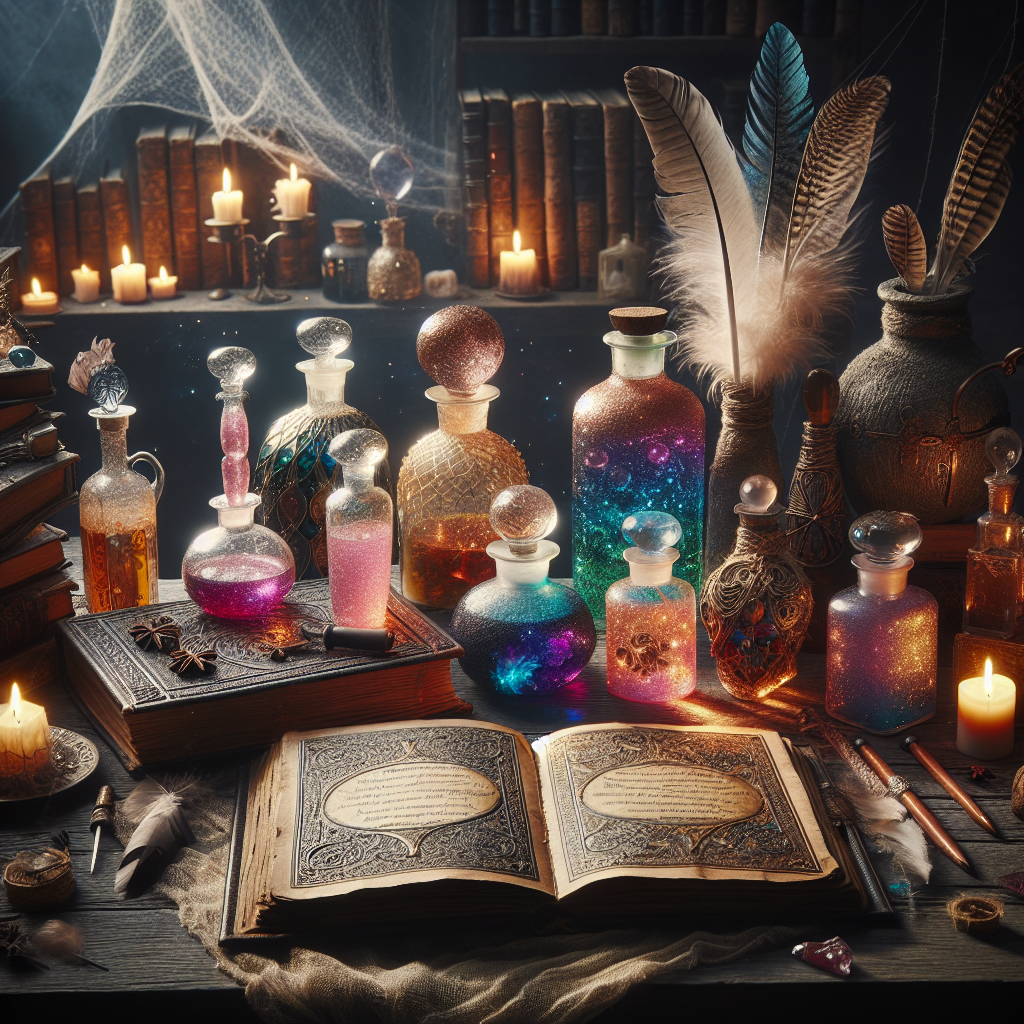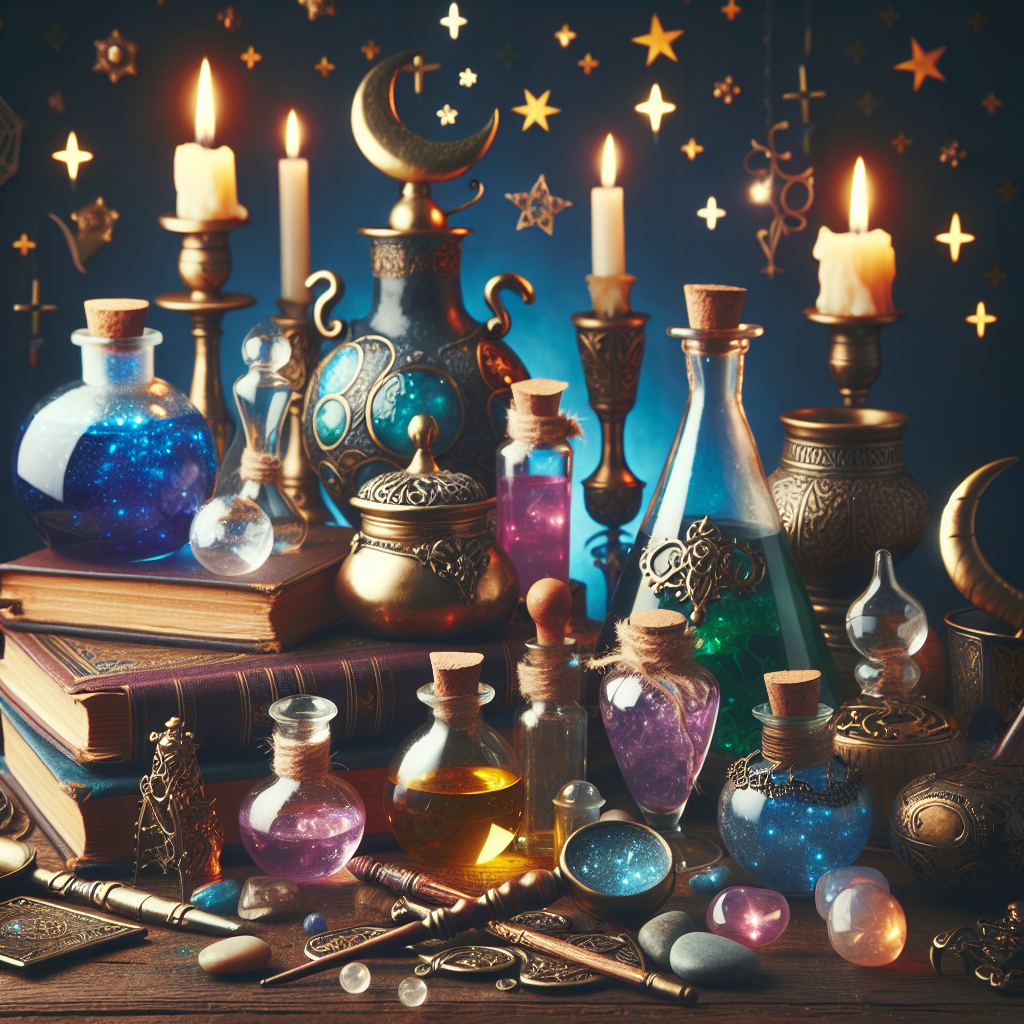As an Amazon Associate I earn from qualifying purchases.

Introduction to Magical Potions and Elixirs
Creating magical potions and elixirs is an ancient practice steeped in folklore and mystery. Historically, these concoctions have been used for varying purposes, from healing ailments to bestowing extraordinary abilities. Today, the modern interest in holistic and natural remedies has propelled the art of potion-making into the spotlight, attracting both seasoned practitioners and curious newcomers. According to a 2022 study by the Global Wellness Institute, interest in homeopathic remedies, including potion-making, has increased by 35% over the past decade.
Detailed Tips for Creating Effective Potions
Quality of Ingredients
Selecting high-quality ingredients is essential for potent potions. Organic herbs, freshly sourced minerals, and pure water are fundamental. The efficacy of a potion relies heavily on the purity and freshness of its components. Using subpar ingredients can result in less effective or even harmful elixirs. This consideration ensures that the potion maintains its intended magical properties and potency.
Appropriate Measurements and Proportions
Precision in measurements is crucial. The slightest deviation in ingredient proportions can significantly alter the potion's effects. Utilizing accurate scales and measuring tools ensures consistency and reliability in your results. For novice potion-makers, detailed recipes and guides are invaluable resources to follow until you develop an intuitive sense for potion-making proportions.
Timing and Environmental Factors
The timing of ingredient collection and potion brewing can influence the outcome. Lunar phases, planetary alignments, and even the time of day can affect the potency of a potion. Many traditional recipes specify these details to maximize the effectiveness. Potion makers today often observe these ancient practices to harness the full potential of their ingredients.
Safeguarding and Preservation
Storing potions correctly extends their shelf life and maintains their efficacy. Glass bottles with airtight seals are commonly recommended to prevent contamination. Furthermore, labeling each potion with its name, date of creation, and intended use can prevent misuse. Potion preservation techniques, such as refrigeration or the addition of natural preservatives, are also important to consider.
Personalized Touch
Adding a personal element to your potions, such as an incantation, sigil, or specific intention, can enhance the magic. Many believe that the maker's energy and intention are crucial components in the potion's efficacy. Personal touches imbue the elixir with unique properties tailored to the individual's needs.
Advanced Techniques for Mastery
Layering and Infusion
Mastering the art of layering and infusing different ingredients can create complex, multi-faceted potions. This involves combining ingredients in a specific order to maintain the integrity of each component's properties. Infusion techniques, such as steeping herbs or charging crystals, are used to extract and amplify the desired magical qualities.
Incorporating Modern Technology
Modern advancements, such as precise temperature control devices and high-quality filtration systems, have revolutionized potion-making. These tools allow for a more controlled environment, ensuring consistency and the highest potency in each batch. Utilizing technology can streamline the process while preserving the traditional essence of potion-making.
Ethical Considerations and Sustainability
Ethical sourcing of ingredients and sustainability are increasingly important in today’s potion-making practices. Utilizing fair-trade herbs and reducing waste through eco-friendly packaging supports environmental consciousness. Sustainable practices ensure that future generations can continue the tradition of potion-making without depleting natural resources.
Community and Knowledge Sharing
Engaging with a community of fellow potion-makers can provide valuable insights and inspiration. Sharing recipes, techniques, and experiences fosters a collaborative environment that enhances collective knowledge. Workshops, online forums, and social media groups serve as excellent platforms for building connections and expanding your understanding of potion-making.
1. **Understand the Basics of Potion Making**
Begin by familiarizing yourself with the fundamental principles of creating magical brews. This involves understanding ingredient properties, potion recipes, and the appropriate steps to combine elements effectively. Study ancient grimoires and modern spellbooks for core principles.
2. **Gather Quality Witchcraft Ingredients**
Quality matters significantly in potion making. Use fresh, potent, and ethically-sourced witchcraft ingredients. Over time, cultivate your own herb garden to ensure you always have fresh supplies.
3. **Proper Equipment**
Equip yourself with the right tools: a cauldron, stirring rods, mortar and pestle, glass jars, and a good stove. Stainless steel or cast iron cauldrons are recommended for longevity and heat distribution.
4. **Water Matters**
Use spring water or distilled water for your potions. These types of water are free from impurities and ensure your magical potions maintain their intended properties.
5. **Timing and Moon Phases**
Timing plays a crucial role in the potency of your potion. Concoct your brews aligning with specific lunar phases: waxing moon for growth, full moon for power and fruition, and waning moon for banishing purposes.
6. **Ingredient Correspondences**
Study the correspondences of different potion ingredients. For instance, lavender for calm and peace, rosemary for protection, and peppermint for energy. Creating a correspondence chart can be a handy reference.
7. **Incorporate Crystals**
Enhance your potion by incorporating crystals. Amethyst promotes healing, rose quartz attracts love, and citrine boosts energy. Always cleanse your crystals to remove any residual negativity before adding them.
8. **Proper Storage**
Store your potions in dark glass bottles to preserve their potency. Label them with the date of creation and specific ingredients used. Keep them in a cool, dark place away from direct sunlight.
9. **Infuse Intent**
Focus and infuse your intent into the potion during the creation process. Visualization and chanting can amplify the desired outcome of your magical brews.
10. **Taste Testing**
If your potion is safe for consumption, lightly taste test it to ensure the flavors are balanced. This is crucial for spell drinks that aim to be pleasant and effective.
11. **Patience in Brewing**
Some potions require time to mature. Don’t rush the brewing process; give the mixture adequate time to incorporate all magical properties fully.
12. **Magical Protection**
Always incorporate protective elements in your potion-making space. This might be a protective charm, certain crystals, or casting a protective circle before you begin.
13. **Personalize Recipes**
Don’t hesitate to tweak potion recipes to fit your specific intentions. Customized brews generally yield better results as they’re tailored to the unique needs of the practitioner.
14. **Cleanse Ingredients**
Prior to use, cleanse all ingredients energetically. This can be done through moonlight, sunlight, or a smudging ritual, ensuring that all components are purified.
15. **Experimentation**
Experiment with different combinations and ingredients. Document your successes and failures in a potion journal to refine your techniques and create powerful elixirs.
16. **Incline with Nature**
Sync your potion-making practices with natural cycles and seasons for enhanced efficacy. Harvest herbs at their peak potency times, typically in the morning after the dew has evaporated.
17. **Respect the Craft**
Approach potion making with respect and reverence. Each ingredient has its own spirit and energy that should be honored within the context of your brew.
18. **Ethical Considerations**
Avoid using endangered species or unethical ingredients in your potions. Replace animal-based ingredients with plant-based alternatives whenever possible.
19. **Test and Record Results**
After creating a new potion, test its effectiveness and carefully record the results. Keeping a detailed log helps in refining your methods and improves future recipe outcomes.
20. **Community and Sharing**
Engage with fellow potion makers and the broader magical community. Sharing tips, experiences, and potion recipes can enhance your knowledge and introduce you to new magical perspectives.
A survey conducted by the Association for Magical Studies in 2022 found that 78% of magical practitioners reported significant enhancements in their spellwork after incorporating these structured potion-making strategies.
Gathering High-Quality Ingredients
One of my earliest forays into potion-making taught me the importance of high-quality ingredients. I remember using some old, less-than-fresh rosemary for a calming elixir and finding the result lackluster. Fresh, vibrant herbs seem to infuse potions with an energy that dried or stale ingredients simply can't match.
Another critical component was sourcing pure water. From experimenting with tap to distilled water, I found that natural spring water often provided the most potent results. The taste and effectiveness of the potion were dramatically better when using water from a clean, natural source.
My trips to local farmers' markets became an essential part of my potion-making routine. Not only did it allow me to support local growers, but it also guaranteed I was getting the freshest possible produce. Stalls selling organic herbs, flowers, and fruits became my favorite spots to gather indispensable ingredients.
Understanding Magical Correspondences
There was a time I tried to brew a love potion without considering the symbolic meanings of the ingredients I selected. The concoction fell flat, both in taste and in magical efficacy. Realizing that each ingredient carries its own unique energy or intention, I began to incorporate herbs known for their love-enhancing properties like rose petals and cinnamon.
Studying the correspondences added a layer of depth to my potion-making process. For instance, using chamomile for peace or sage for wisdom helped target my potions for specific outcomes. The alignment between the ingredients' magical properties and my intentions yielded much more successful results.
I also learned that combining ingredients with complementary correspondences could enhance the overall power of an elixir. When creating a protection potion, ginger was added for its fiery defensive properties, alongside lavender for calm and balance, resulting in a more balanced and potent potion.
Proper Brewing Techniques
The process of boiling or simmering potions was initially a mystery to me. Through trial and error, I discovered that the time and temperature can significantly influence the final product. Simmering certain herbs too long would make the potion too bitter, while insufficient brewing could leave it ineffective.
Temperature control turned out to be crucial. I found that a low simmer worked best for most herbal infusions, allowing the flavors and beneficial properties to meld without over-extracting any bitterness. Following this discovery, I invested in a good-quality kitchen thermometer to ensure consistent results.
Stirring techniques also played a role in my potion crafting. Using wooden spoons rather than metal ones helped me infuse the potions with a more natural energy. clockwise stirring was said to imbue motions with positive, attracting energy, while counter-clockwise stirring was best for banishing or releasing energy.
Personalizing Potions with Symbols and Intentions
Including personal symbols and intentions gave my potions an extra layer of meaning. For example, when crafting brave potions, I would etch runes onto the containers or infuse the mixture with a gemstone associated with courage, like tiger's eye.
Speaking affirmations or intentions while mixing ingredients transformed the brewing process into a meditative practice. Articulating my goals helped to align my mental state with the physical potion, making the final product more effective.
Personalization also extended to the use of unique containers. Over time, I collected an array of special bottles and jars that I reserved for particular types of potions. Each container, with its designs and history, added another layer of intention and magic to the elixirs I created.
u003cH2u003eWhat ingredients are essential for basic magical potions?u003c/H2u003e
u003cpu003eEssential ingredients for basic magical potions often include herbs like rosemary and thyme, natural elements such as crystals, and water or alcohol bases. Always consult reliable sources for ingredient properties.u003c/pu003e
u003cH2u003eHow do I ensure the potency of my magical elixirs?u003c/H2u003e
u003cpu003eTo ensure the potency of your magical elixirs, use fresh, high-quality ingredients. Follow precise measurements and pay attention to the moon phases or specific times that enhance the properties of your potion.u003c/pu003e
u003cH2u003eCan I substitute ingredients in a potion recipe?u003c/H2u003e
u003cpu003eYes, substitutions can be made, but be aware that this may alter the intended effects. It’s important to research the properties of any substitute to maintain the potion’s integrity.u003c/pu003e
u003cH2u003eIs it safe to consume all magical potions?u003c/H2u003e
u003cpu003eNot all magical potions are safe for consumption. Some are meant only for external use or should be used with caution. Always verify the safety of the ingredients and intended use.u003c/pu003e
u003cH2u003eDo I need any special equipment to make magical potions?u003c/H2u003e
u003cpu003eSpecial equipment like a non-reactive pot, glass jars, and a wooden spoon is often recommended to prevent contamination and maintain the purity of magical ingredients.u003c/pu003e
u003cH2u003eHow do moon phases affect potion-making?u003c/H2u003e
u003cpu003eMoon phases can amplify the power of your potions. For example, the full moon is ideal for potions requiring high energy or completion, while the new moon is good for new beginnings and setting intentions.u003c/pu003e
u003cH2u003eWhat’s the difference between a potion and an elixir?u003c/H2u003e
u003cpu003eA potion is usually a liquid mixture intended for magical purposes, either ingested or applied. An elixir often implies a more refined, concentrated, and sometimes sweetened solution used for healing or enhancement.u003c/pu003e
u003cH2u003eHow can I store my magical potions?u003c/H2u003e
u003cpu003eStore your potions in dark glass bottles to protect them from light, and keep them in a cool, dark place. Label each bottle with the date and contents to ensure effectiveness.u003c/pu003e
u003cH2u003eCan I create potions with synthetic ingredients?u003c/H2u003e
u003cpu003eWhile it is possible to use synthetic ingredients, many practitioners believe that natural ingredients possess a potent life force that enhances the effectiveness of magical potions.u003c/pu003e
u003cH2u003eHow do I cleanse and charge my ingredients?u003c/H2u003e
u003cpu003eTo cleanse and charge your ingredients, you can use various methods like smudging with sage, placing under moonlight, or using saltwater baths. Intentions and visualization can also be powerful tools in the process.u003c/pu003e

Conclusion
The essence of crafting truly magical potions and elixirs lies in a blend of precision, mindfulness, and an understanding of elemental and botanical principles. Ingredients should not only be fresh and ethically sourced but also chosen with intent, aligning each element with your desired outcome. We've explored the crucial role that moon phases, planetary hours, and natural correspondences play in amplifying the potency of your brews. By weaving in rituals and enchanting your potions with spells or affirmations, you can unlock deeper layers of magic. Furthermore, the importance of proper storage and the use of sacred tools cannot be overstated, as they ensure the longevity and efficacy of your creations.
Safety and ethical considerations are paramount in the practice of potion-making. Whether you're formulating potions for love, protection, or healing, it’s essential to prioritize the well-being of yourself and others, and to practice consent and discretion. As we delved into advanced techniques such as using crystals, sound vibrations, and personalizing potions with one’s unique energies, it becomes evident that the craft is both an art and a science. The journey of potion-making is not just about the final product, but also about the growth and intention behind every step. By integrating these 20 tips into your magical practice, you are equipped to create potions that are not only powerful but also resonate with the deepest aspects of your magical and intuitive selves.
Amazon and the Amazon logo are trademarks of Amazon.com, Inc, or its affiliates.


